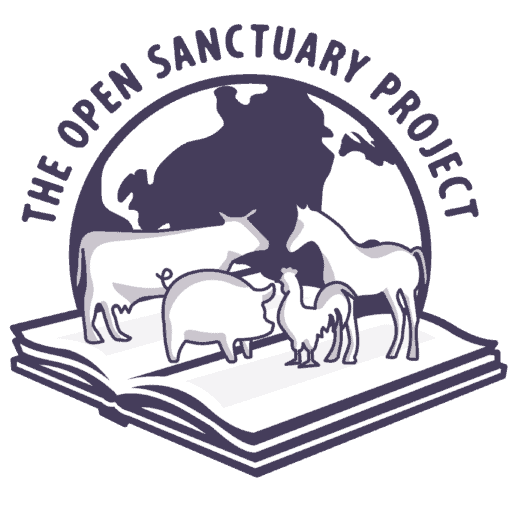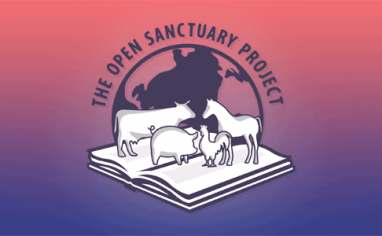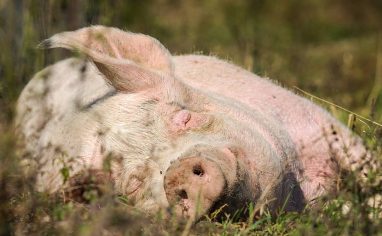
Subscribe To The Open Sanctuary Podcast
If you’d like to get the latest episodes of The Open Sanctuary Podcast, you can subscribe for free on all Podcast platforms, including Apple Podcasts and Spotify!
Episode Notes
Senior Advisor Tara and NonprofitA non-governmental organization whose primary purpose is something other than selling goods or services. Specialist Julia continue their rooster stigma discussion, debunking common rooster myths and stereotypes. We share ways that you as a sanctuary can actively bust rooster stigma through the adoption of careful language use, thoughtful educational programming, and considering how you approach your rooster residents in your day-to-day care practices!
—
This Episode’s Referenced Open Sanctuary Project Resources:
Introduction To Rooster Behavior Part I: Dismantling Rooster Stigma
Maintaining A Healthy Rooster Flock
Breaking The Mold: How Animal-Centered Design Can Transform Sanctuaries
Fun Facts About Roosters Infographic
Dismantling Rooster Stigma Infographics
The Open Sanctuary Project’s So You Want To Rescue A Rooster Brochure
Episode Transcript (Auto-GeneratedThe following content was transcribed through an automated process and may contain transcription errors or misspellings.)
Julia Magnus So, in our last episode of the Open Sanctuary Podcast, we were talking about rooster stigma. Tara Hess is our senior advisor. I’m the nonprofit specialist, and we’re both fellow bird nerds at the Open Sanctuary Project. And so we’ve collaborated a lot on bird-related matters, including a comprehensive resource on rooster stigma. So in our last episode on this subject, we spent some time talking about a lot of the stereotypes, a lot of the stigmas, a lot of the misconceptions around chickens, how they work. And so now we’re going to do a whole other episode on how we as sanctuaries, caregivers, and rescuers can work together to actively dismantle rooster stigma. Let’s do it. So, in the last episode, when we were talking about different common stereotypes about roosters, specifically in birds generally, one of the things we talked about was this notion that they’re aggressive. And so, one thing that Julia and I have had conversations about, along with other rooster rescuers, is the importance of the language that we use. And this doesn’t just apply to roosters, surely, but because it’s such a widespread myth that roosters are aggressive, really thinking about the language that we use when we’re describing their behavior, I think, is so important. So, I just think like, remove aggressive from your brain when you’re talking about roosters and flip it to this concept of like, as prey animals, they are defending themselves. This is self-defense. Sometimes even being like, “Look, they are scared, they are fearful, they feel threatened.” Flipping it as opposed to being like, “They’re aggressive. Look at them attacking me.” I think that can go a really long way. And not just using that language when you’re talking to the public, which for sure is important, but when you’re talking with other caregivers, I feel like even when you’re just thinking about what you’re seeing, just really reframing it and just ditching this notion of aggression. And even if there’s some unique situation where a certain rooster is doing a certain thing that you feel is like, I would just nope, like, just get away from this notion of aggression and remind yourself that you are a threat or whatever the situation is. Or you know, it’s not always a rooster kicking you. Sometimes, like you said in the last episode, just their natural, the way they interact with hens, the way chicken flocks work. Sometimes they’re just doing normal, fine things and people think they’re aggressive. So really using intentional language, I think, is one really important thing that we can do both within the sanctuary community and when advocating for roosters with the public. I definitely agree with you because I’ve even seen rescue-adjacent or rescue-related organizations talking about roosters as aggressive, and it just… I’m not sure what that adds to any understanding of the individuals that you’re talking about. And that brings me to the point that every rooster is an individual. Every rooster has their own story and their own background. So while many roosters can and do coexist in rooster flocks peacefully with one another, there may be some that may not be able to do so, and that’s not necessarily a function of being aggressive. In most cases where I’ve seen that, that’s a function of trauma and again, a function of human behavior related to exploitative activities like cockfighting. In those cases, we generally do recommend that those roosters coming from that kind of background not have to be forced to be around other roosters in ways that might be triggering their self-defense mechanisms or their trauma. But I think that those are special cases. And yes, you may encounter certain rooster individuals who really aren’t big fans about being around other roosters, but in general, all of this behavior, regardless of their background, regardless of their history, regardless of anything, is all self-defense. It’s not aggression. It’s just inherent to their nature as prey animals to take care of themselves and the people that they care about. And so yeah, that language choice is wildly important. So in terms of education efforts on behalf of roosters and how we can incorporate those language changes into education efforts that might promote better understanding of roosters in the larger community, what kind of tips do you think are helpful, Tara?
Tara Hess I mean, I think for starters, explaining who they are and how they behave, where they come from, like you talked about in the last episode, we’ve as like a society, I just feel like for so many of these farmed animalA species or specific breed of animal that is raised by humans for the use of their bodies or what comes from their bodies. species, we’ve totally removed them from who they actually are and who their ancestors are and now only see them as, oh, chicken, live on a pasture in a farm, and that’s just who they are, and it’s just so far from the truth. So I think educating the public by letting them know where they came from, how they got here, the fact that we did this, like this didn’t, this didn’t just happen. And it’s important, you need to do both. A lot of times we talk about what happens to them right now in terms of farming and the way humans treat them, but it’s important to explain who they actually are. Because without that part, you can know that, oh, roosters are treated terribly and here are all the bad things that happen to them. But if you still totally have no sense of who they are, that they’re prey animals, the role they have in their flock, you’re not going to understand who they are, and how do you advocate for someone who you don’t know? That just seems very difficult. So, I think as much as we can do that, and not just sanctuaries, but sanctuaries are well positioned to do that because you know, you hopefully have like an intimate knowledge of who certain individual roosters are and can share their story to illustrate the general points that you’re making that you know, they descended from wild jungle fowl, that they play a certain role in their flock, that they can coexist with other roosters, that they’re individuals. All these points, I think, are really important in terms of dismantling the stigmas that people have about them. And I think one of the other areas is talking about their abilities. Again, that’s a tricky tightrope to walk. You don’t want to justify treating somebody differently based on their relationality to humans. But there are a lot of really interesting things about chicken cognition, chicken senses that can really make people think twice about who these birds are and how they work, that make them realize that they’re not either myth one: stupid, or myth two: they have no personality, that they’re just sort of beings who have no senses or no real awareness or cognition of the world around them. Educating people about their senses and cognition helps, keeping in mind that their relationality to humans is not the criteria on which they deserve consideration. So when it comes to communities and talking to communities, it can be very difficult because even in areas where roosters are allowed, and unfortunately, roosters do tend to suffer a lot as a function of many communities just banning them outright, which it’s not humane to ban half of a species just based on their sex, but it happens. But even in communities where they are not banned, and that includes my hometown of Chicago, we still find folks who suffer from misconceptions around roosters. So storytelling, like you said, telling the stories of the individual lives of roosters, talking about their unique abilities, capacities, and the joy of actually living with them. I mean, I think we probably both have many stories about living with rooster companions. I think one thing that I was really happy that made it into the rooster stigma resource was looking at Leonard Crowin, who was one of my first roosters, who I was busy feeding everyone in the morning, and he went into the trash because I had mistakenly put a banana peel in the trash instead of the compost. And he took it out. He brought it to me and he was like, “Here is the banana peel. How about you have it? Do you want it? Here’s a present for you.” Like these little moments with these birds, it’s heart-melting.
Julia Magnus Mhm. I know that you have similar stories, but just sharing these stories is really important. They need to make folks realize that every one of them is an individual with a unique personality and a unique sense of intelligence. Yeah. Yeah. Like you said, I mean, I’m sure we could have ten podcast episodes about some of our favorite rooster stories, but sharing our home with Cantaloupe, and this is after years of caring for roosters in a sanctuary context where I was part of a team caring for birds living in flocks and out, you know, in their own like homes, but caring for Cantaloupe inside, which was of course like weird depending on who I’m talking to. And again, they’re all individuals, so I’m not saying go out and rescue a rooster and they’ll sit on your lap every night. But that was Cantaloupe. Cantaloupe was an old dude. He was arthritic. He was super, super, super chill. And every evening he would sit on my lap. I would pick him up and put him there. He could leave if he wanted, but he wasn’t much of a jumper. So, I had to like pick him up and put him there. Then he’d get situated and snuggle right in on the armchair with me. And I would read. And he would sit there for as long as I would sit there reading almost every night. Every once in a while, if he got hot or something, he would jump down. So, I have all these pictures that are just rooster legs, book, you know, that’s like the whole picture. And I love sharing those with people because I just feel like that is not what people picture when they think of a rooster. You could take him out and put a cat there and it would feel much more like, oh yes, like the lap cat. But he was a lap rooster. There were so many things that were amazing about him, but I felt like that was the thing that always caught people off guard if they witnessed it in person or I showed them a picture. Something because he’s also not, he wasn’t a tiny rooster. He was a big rooster. You know, I feel like he’s the kind of rooster that someone would be scared of if they weren’t sure about roosters. And here he is just like straight up chilling on my lap while I read a book and while I have a kidA young goat on the ground laying video games and he’s totally, totally fine. So, you know, everyone’s going to have their own little story, but sharing those stories as opposed to, you know, like a picture of like a bite, because I got bit because I did, you know, I did something that I knew was going to upset him or I know that he’s feeling a certain kind of way because the spring hormones are really kicking in. You know, I feel like there’s a way to share a story or a situation out of context that’s going to reinforce some ideas people have. And then there are the stories that you can share that people are going to be like, “Wait, what? Like a lap rooster? Seriously, what? The rooster brought you a banana as a treat?” Like, I don’t know. I feel like those are those are the ones that deserve to really be told a lot.
Tara Hess I totally agree, and I feel like these are things even when sanctuaries or rescues are receiving owner surrenderThe act of transferring guardianship of an animal to a person or organization, especially via legal contract. requests. Mostly, I think they’re functioning out of fear when you get these owner surrender requests. It’s like, oh, this rooster is aggressive or they’re aggressive to hens or they’re threatening my children. Calm, calm, take a breath. This is not who roosters are, and it’s very frustrating when you’re working in rescue and particularly with rooster requests because they’re so common. You see them every day, and then you’re like, “Go away. Just get out and stop.” I mean, auto-replies can help with that, but also just trying to share a little bit about why educating the owner surrender would be in ways that might be educational, like just trying to give links to rooster links to infographics. We have multiple infographics on OSP that are really cute, and they can be quick ways to digest information and dismantle certain myths around birds and, you know, specifically rooster behavior that are quick digests, as well as our resource on rooster flocks. There are a number of different things that you can share from our site that can help just be quick entry points into people understanding roosters in a different light. It’s hard. I know that it’s hard. Trust me, I know that it’s hard. When you get the owner surrender request, but looking at it as an opportunity for education can be really helpful for our rooster friends. You can urge rooster retention. You can talk about indoor chickens. I’m sure some of the folks calling trying to find a place for their rooster maybe wouldn’t be… not everyone’s going to be like, “Oh, bring them indoors. Sure, like I can do that or I want to do that.” But I think for folks who are willing to listen to that as an option, that’s like a huge one. Especially when it comes to situations where the underlying concern is that like neighbors are getting upset, because we can say all day like, oh, their crow is no worse than like a leaf blower. But again, I feel like people are just… I’m generalizing, but because there are all these stereotypes about roosters, it’s like you said, they can’t do anything. Right. People just take for granted. They might complain about like a leaf blower going down the street, but it’s sort of like, oh, that just happens. But like a rooster, like they can’t be crowing, you know? So, if you have someone who’s at their wits’ end because their neighbors are getting annoyed that a rooster’s crowing, bringing them inside is… I mean, that can really solve some problems and help with retention. And you know what? It is a whole thing where a lot of the requests that we get here are like, well, we hatched, and now we have a rooster. Oh no. And I’m like, “Not oh no, congratulations. You have a very good boy.” And they’re like, “Oh, we’re so scared our neighbors are going to be mad.” Okay, well, just keep him, keep him inside overnight, you know, you can easily do that. You can have them be an indoor-outdoor bird, and that’s going to work just fine. You can accommodate your neighbors like in urban settings. There are ways to work around that. And the indoor chicken resource is really invaluable for ways of helping you to do that. So all these resources in conjunction can be really helpful for your sanctuary while you navigate owner surrender requests. Even when you get requests from shelters or ACOs, you can help them help people by giving them this information that most of them may not have ever been aware of. So like in caregiving contexts, how do we best set up in sanctuary and rescue contexts? So as we move from like informing the public and like how do we as sanctuaries and rescues start thinking about how we can best promote the well-being of the roosters in our care and set them up for success, like set up situations where people can see how roosters truly can live safely, happily, and free from fear or exploitationExploitation is characterized by the abuse of a position of physical, psychological, emotional, social, or economic vulnerability to obtain agreement from someone (e.g., humans and nonhuman animals) or something (e.g, land and water) that is unable to reasonably refuse an offer or demand. It is also characterized by excessive self gain at the expense of something or someone else’s labor, well-being, and/or existence.. What are some tips? I mean, the first tip I feel like you already touched on, but I think really taking time to learn about and consider who they are in terms of their ancestors, in terms of their needs and preferences, which some of it is going to be individualized, but there are also some like generalizations that can be made about chickens. And then creating living spaces that honor and reflect that and that promote not just their physical safety because obviously predator proofing is just like a huge, huge thing that I’m sure we’ll eventually do, or we did do an episode on that.
Julia Magnus We actually did. We already did an episode on that. My brain is just not working. There is another episode of this podcast on predator proofing as well as a resource on that.
Tara Hess Yeah. So, we talked all about that. So, like yes, predator proofing is important, but they also need to feel safe. So, if you think about who they are and who their ancestors are and that they were in forested spaces, not in these open fields, and you consider the fact that they’re prey animals again, and that threats are a very real thing for them. Then you, you know, you start putting these pieces together and you’re like, “Oh, maybe they need some like low shrubs. Maybe they need some evergreens also so that in the winter there’s coverage. Maybe we can make things.” And it doesn’t have to be elaborate. Maybe it’s a carrier that’s cleaned out regularly that has a towel in it or some sort of tunnel that they can go in. But as much as you can give them a space and give them choices so that they can go where they want, do what they want while being safe and while feeling safe, what we talked about earlier where you get to sort of like see who they are in their best setting. If you can create that, then I think that goes a long way. And I’m not saying that if a rooster has shrubs and coverage and all this stuff that like they’re never going to peck you if you go to pick up their closest companion or something. But if they feel safe, that is going to have an impact on how they spend their time and what they feel comfortable doing. So I think living spaces and then social arrangements, like those two things are huge, creating safe flock dynamics for them, which I know can maybe take some additional consideration when you’re dealing with ex-fighters, which you have a bit more experience with me dealing with.
Julia Magnus I mean, I would also add that making sure that roosters know that you are their friend and not their foe is helpful in caregiving spaces. I’ve only met a few roosters. If you bring them some really good goodies and you offer them to the rooster, he’s going to be like, “Yeah, yeah, buddy.” And then he’s going to start dropping those around for his friends and he’s like, “I did this.” And he’s like, “Look what I got.” And it will, it will like make his opinion of you better generally. He’s going to be like, “All right, this is a person who made me look good.” So there are other things that you can do like treat-wise. There have been a lot of discussions in lots of realms about things that you can… things like brooming roosters away from you or separating. You don’t want to alienate your rooster or make him think that you’re a threat. You want him to be your friend. So give him things. Give him things he likes and that he can distribute to his family as he sees fit. You can, if he feels comfortable, pick him up and give him like a nice little comba fleshy crest on the head of the domestic chicken and other domesticated birds and wattlea fleshy pendulous process usually about the head or neck (as of a bird) rub because they generally do tend to like that, and just put him down when he’s ready. And so those kinds of things in addition to providing him with a proper environment are… they can go a long way. One thing that was really, there were lots of things that were eye-opening about caring for Cantaloupe because you know, I was like, I have rooster experience, I have chicken experience, like I’ve been doing this for ten years. But one thing that was really eye-opening caring for him was I just had so much more time to be with him. And I know that depending on the circumstances, like caregiving can just be really, really busy and a never-ending to-do list. But if you can build in opportunities to just be there and maybe that sort of starts out further away just as like a presence over, you know, a divider and then in but like not doing anything, because sometimes we just go in and we have to clean and so then like people have to move or we have to, you know, collect eggs. And so then, you know, we’re sometimes disturbing hens or something like that, or we have to do spura stiff sharp spine (as on the wings or legs of a bird or insect) trimming. You know, if your only interactions really are when you’re like, “I’m going to trim your nails, and I’m going to trim your spurs, and I’m going to kick you out for a little bit so I can clean in here,” like…
Tara Hess That’s… those are important things, but if that’s the bulk of your relationship, then I feel like it’s silly for us to be like, “Why don’t we have a better relationship with this rooster?”
Julia Magnus Yeah. Why would I be friends with you if all you’re doing is like slamming a cage over me, separating me from my family? Yeah.
Tara Hess And then like grinding my feet and like what is, you know, why would I be your friend if I were a rooster? Instead, if you just go in every day and you’re like, “Hey, you want some blueberries?” And he’s like, and then starts the whole process for his family. So like it’s the environment. It’s just the day-to-day interaction and affirmation of the rooster, like giving him the stuff so he can then take credit for it and give it to his family.
Julia Magnus Yeah, totally.
Tara Hess And then, yeah, there are going to be certain roosters who may not ever want to be your friend. They may not ever want to get along, and that’s fine. And especially that can happen in the context of ex-fighters and survivors of cockfighting. It’s just better at that point. Give them the space they need, absent needing to handle them for healthcare purposes. Don’t retraumatize them by exposing them to other roosters, and they will do often times many of them very well with a single hen, and let them do that. It takes time. Many of them come around, some of them may not, and that’s also okay. They’ve been through a lot. Yeah. Yeah. I think another thing that is just like a good life lesson that I’m not necessarily good at all the time, but is focusing on what you can do as opposed to being fixated on what someone else is doing and the thing that you have no control over but you wish they would change. And then also just keeping things in perspective. I have evolved in the last fifteen years, and if I was all of a sudden caring for some of the individuals I cared for fifteen years ago, I feel like I have some information that I maybe didn’t have back then. But that being said, I’ve certainly worked with individuals who I would get kicked or, you know, whatever would happen. I just feel like we should focus a bit on… and I can’t make them not kick me. Like maybe I could like separate them or do something that maybe is going to backfire in terms of like keeping them totally away from me that I wouldn’t necessarily recommend, but I can wear thick pants and I can wear boots that come up to my knees, you know? Like I can protect my legs so that that kick I barely feel it, you know? I can wear like coveralls over things. I can wear long sleeves as opposed to going in with a t-shirt. I just feel like we can do things that make us feel more protected so that we can feel more confident around them and so that we don’t have to fixate on them being a problem and just being like, this is what happens sometimes. I will wear long pants and I will be fine, and then keeping it in perspective of like what is the worst they’re going to do. Again, those stories of like roosters killing humans, that is not the same as just a rooster at a sanctuary, you know, like kicking somebody. Those are like extreme situations where there are like blades and things involved that just are not going to be a presence. I feel like we can make it more of a thing than it needs to be because there are other animals at a farmed animal sanctuaryAn animal sanctuary that primarily cares for rescued animals that were farmed by humans. that could do so, so, so much more damage to you than a two, five, ten, even like a fifteen-pound rooster. I’m basically screaming in my own head at this point because this is so real, because for me, I grew up with large parrots, and I have many scars, and that’s cool. But roosters are small. They’re small. Their bones, many of them are hollow. They are small, delicate creatures. One blow from a human can destroy one. And one kick from a rooster is certainly not going to destroy a human. So, like, let’s be real about who they are, what their capacities are, and why they are this way. And just take that into consideration for making them into some sort of demon-kicking Satan bird that they just… they’re not capable of doing that much harmThe infliction of mental, emotional, and/or physical pain, suffering, or loss. Harm can occur intentionally or unintentionally and directly or indirectly. Someone can intentionally cause direct harm (e.g., punitively cutting a sheep's skin while shearing them) or unintentionally cause direct harm (e.g., your hand slips while shearing a sheep, causing an accidental wound on their skin). Likewise, someone can intentionally cause indirect harm (e.g., selling socks made from a sanctuary resident's wool and encouraging folks who purchase them to buy more products made from the wool of farmed sheep) or unintentionally cause indirect harm (e.g., selling socks made from a sanctuary resident's wool, which inadvertently perpetuates the idea that it is ok to commodify sheep for their wool).. And if you take these basic precautions like wearing high boots and pants, it’s very unlikely you’re ever going to be significantly harmed by a rooster. So protect yourself, give them the space to just understand that. And often times the thing is, is once they have kicked, they’ll retreat, you know. They’re like, “Okay, I did my, I did my thing. Now you’re warned.” Like, “Okay, cool, bud. I’ll just keep doing my thing.” And this is a thing, I think, when we also transition from talking about caregiverSomeone who provides daily care, specifically for animal residents at an animal sanctuary, shelter, or rescue. precautions that you can take and how you communicate with guests or visitors or anybody who might come to your sanctuary or rescue wanting to learn more about roosters. We’ve talked a lot about language use. I’m sure you have some other thoughts on that.
Julia Magnus Yeah. So, I think like when I think of interacting with guests, visitors, or even the information we put if you like put stuff online, I think it’s a combination of being really thoughtful about the language that you use and then also I guess always having in mind, think about how something could be misconstrued or how someone might misunderstand something. And so, preemptively provide context or describe what’s going on so that folks understand, because even if you like, if you do tours, if you’re a sanctuary that does tours, even if you’re not bringing people in right now with a certain group of birds, if you’re walking by and you see that the rooster has quickly mounted someone and then walked away, that’s a great educational opportunity to just explain what happened. Explain the rooster’s role in the flock. Explain who these individuals are because people see things and they’re always going to make connections in their brain, right or wrong. And if they don’t have all the information, then it’s probably going to be the wrong conclusion to come to. So, I think don’t take for granted that folks just know things. Just provide as much context as you can. And then another thing that’s sort of related to language that I know like I’ve had to work on over the years is being careful how we’re explaining a certain situation where you can maybe more objectively explain what happened. I’ve been kicked, I’m sure, by a rooster in front of people. And I don’t know that I necessarily used it as a good opportunity to explain what was going on. I might have just been like, “Ah,” you know, or like you might joke and be like, “He hates me,” or whatever. Like these are, you know, I wasn’t trying to be a jerk, but like that wouldn’t have been the right way. I wouldn’t handle it that way now. I would explain what’s going on. That they’re again, that they’re prey animals, that they’re protecting their people, that I’m a threat or that I did, like, “Look, I just picked up his companion and he doesn’t like that and he needs to protect her,” and this is how he’s doing it. And so really explaining things in an objective way and without using that to then label the individual, again, like no aggression, no like he hates people or he’s mean or whatever. You can just objectively describe the fact that this is how he is protecting himself. He feels threatened and this was his response. I think can be helpful, but like for me, that’s not always, wasn’t always like the first thought in those situations. Yeah. Yeah. I feel like that’s pretty normal in like high stress situations if somebody’s kicking or somebody’s got feelings that can happen. And but yeah, it is, it is good to just sort of really ingrain your brain both for your sake as a caregiver and also for the sake of how you communicate externally to fully understand these birds and convey that understanding to others that prey animal. I feel like we said it so many times in that resource: they are prey… because it’s so important. If you don’t understand that point, and they’re domesticatedAdapted over time (as by selective breeding) from a wild or natural state to life in close association with and to the benefit of humans, they don’t have many protections built in. They just are not, they are very vulnerable creatures, and so it’s really important that we set them up for the happiest, safest life that we can. And then try and as much as possible with this stigma, this nasty stigma that accompanies birds generally, but specifically roosters. We work so hard as caregivers and as educators and compassionate advocates to do our best to dismantle all the myths around it. We do hope that our resource is useful in this light because we do cover as much as this may have gone into a two-podcast episode on rooster stigma, I’m sure that we could talk about it even more because we are very passionate about these birds. But we do hope this gives you like an introduction that the resource itself can help you delve into other areas of bird cognition, sensation, how mating behaviors work. There’s lots of different aspects that are covered, and that we hope, we hope very much that this will help you in your process when it comes to both understanding roosters yourselves and also doing compassionate outreachAn activity or campaign to share information with the public or a specific group. Typically used in reference to an organization’s efforts to share their mission. on their behalf for the public.

Got A Podcast Idea? Contact Us!
If you have a topic or question you’d love to hear our staff address on The Open Sanctuary Podcast, please get in touch via our contact form!








